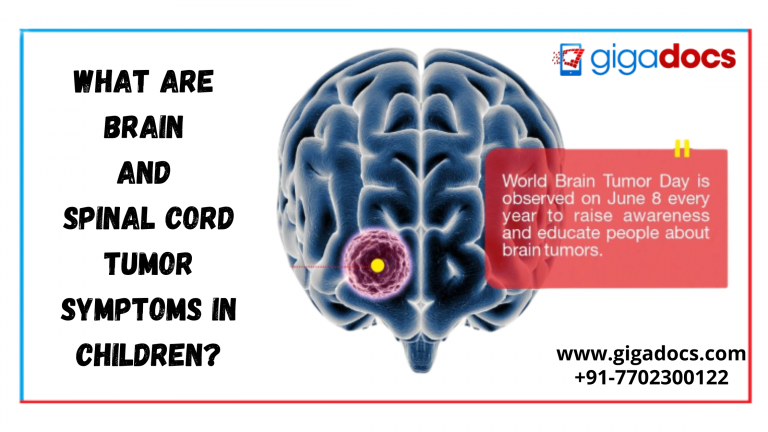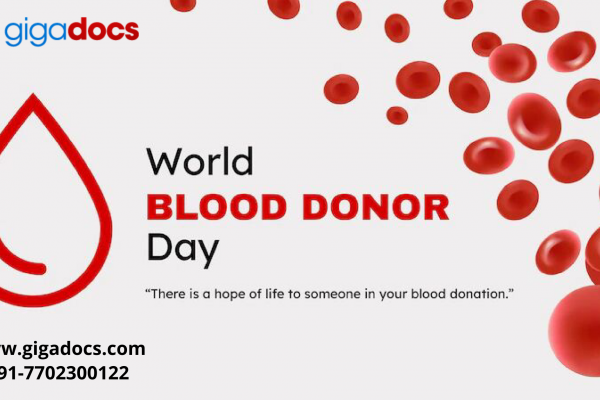A brain tumor is an abnormal growth or mass of cells that develop within the brain. These tumors can originate from brain cells or may result from cancer that has spread (metastasized) from other body parts. There are two main types of brain tumors, Primary Brain Tumors and Metastatic Brain Tumors.
Every year the 8th of June is celebrated as World Brain Tumor Day. Did you know in India, brain-related tumors are 5-10 per 100,000 people? The International Association of Cancer Registries (IARC) reported over 25,000 cases of brain tumors reported in India each year, and more than 20,000 people reportedly die due to brain tumors annually.
In this blog, we bring your attention to pediatric brain tumors and discuss how common pediatric brain tumors are, the most common age when children get inflicted with a brain tumor, discuss the types of brain tumors in children covering primary, metastatic, benign, malignant tumors, the warning signs and symptoms as a parent you should know before diagnosis.
Are Brain Tumors Common in Kids?
Brain tumors are relatively rare in children compared to adults. However, brain tumors are the second most common type of cancer in children (after leukemia); for instance, according to the American Cancer Society, brain and central nervous system tumors makeup about 26% of all childhood cancers.
Did you know the types of brain tumors in children can differ from those in adults? The most common types of brain tumors in children include:
- Medulloblastomas: These tumors usually develop in the cerebellum, the part of the brain that controls balance and coordination. Medulloblastomas are high-grade tumors and tend to occur more frequently in children.
- Gliomas: Gliomas in children include astrocytomas, ependymomas, and brainstem gliomas. These tumors can develop in various parts of the brain and spinal cord.
- Craniopharyngiomas: These tumors form near the pituitary gland at the brain’s base. They are usually benign but can cause hormonal and vision problems due to their location.
- Ependymomas: Ependymomas are tumors that develop from the cells lining the ventricles or the spinal canal. They can occur at any age, but some types are more common in children.
At what age do Children get Brain Tumors?
Brain tumors can occur at any age, including in children. However, the incidence of brain tumors varies depending on the age group. The types of brain tumors that are more common in children tend to occur predominantly during specific age ranges, like-
| Child’s age group | Type of Brain Tumour |
| Infants and Toddlers | Embryonal tumors like medulloblastomas and primitive neuroectodermal tumors (PNETs) are more common in young children, especially under three. |
| Children and Adolescents | Brain tumors are more frequently diagnosed in children and adolescents. The peak incidence occurs between ages 3 and 12. Brain tumors, including low-grade gliomas (such as pilocytic astrocytomas), ependymomas, and brainstem gliomas, are more prevalent in this age group. |
| Teenagers and Young Adults | Certain brain tumors, including high-grade gliomas like glioblastomas, can occur in teenagers and young adults. |
Types of Malignant Brain Tumors in Children-Primary, Metastatic, Benign, Malignant
Malignant brain tumors in children, also known as pediatric high-grade brain tumors, can include several types. These tumors are aggressive and can potentially spread and invade nearby brain tissue. Here are some of the common malignant brain tumors that can occur in children:
- Medulloblastoma: Medulloblastomas are fast-growing tumors that develop in the cerebellum (the part of the brain responsible for balance and coordination). They are more common in children, especially between 3 and 8. Medulloblastomas can spread to other parts of the brain and spinal cord.
- High-grade Gliomas: High-grade gliomas in children include tumors like glioblastomas and anaplastic astrocytomas. These tumors arise from aggressive glial cells that tend to overgrow. High-grade gliomas can occur in various regions of the brain.
- Diffuse Intrinsic Pontine Glioma (DIPG): DIPG is a high-grade glioma that affects the brainstem. DIPG tumors are diagnosed in children between the ages of five and nine. DIPG is challenging to treat due to the location of the tumor cells within the brainstem.
- Atypical Teratoid/Rhabdoid Tumor (AT/RT): AT/RT is characterized by losing a specific tumor suppressor gene called INI1 or SMARCB1. AT/RT is a rare and aggressive tumor primarily affecting young children, particularly under three. It can develop anywhere in the central nervous system, including the brain.
- Embryonal Tumors: Embryonal tumors are a group of malignant brain tumors that include various subtypes like embryonal tumors with multilayered rosettes (ETMR), atypical teratoid/rhabdoid tumors (AT/RT), and medulloepithelioma. These tumors tend to occur in young children and have distinct microscopic features.
Each of these tumor types has different characteristics, including their location, growth pattern, and response to treatment. The specific treatment plan is determined based on tumor type, location, stage, and the child’s overall health. Let’s understand what are the warning signs you must know to diagnose brain and spinal cord tumors-
Brain and Spinal Cord Tumors in Children: Warning Signs You Should Know
Recognizing the warning signs of brain and spinal cord tumors in children is crucial for early detection and prompt medical attention. Here are some common warning signs that parents and caregivers should be aware of:
- Weakness or Numbness: Weakness or numbness in the arms or legs, mainly if it occurs on one side of the body.
A brain tumor is an abnormal growth or mass of cells that develop within the brain. These tumors can originate from brain cells or may result from cancer that has spread (metastasized) from other body parts. There are two main types of brain tumors, Primary Brain Tumors and Metastatic Brain Tumors.
Every year the 8th of June is celebrated as World Brain Tumor Day. Did you know in India, brain-related tumors are 5-10 per 100,000 people? The International Association of Cancer Registries (IARC) reported over 25,000 cases of brain tumors reported in India each year, and more than 20,000 people reportedly die due to brain tumors annually.
In this blog, we bring your attention to pediatric brain tumors and discuss how common pediatric brain tumors are, the most common age when children get inflicted with a brain tumor, discuss the types of brain tumors in children covering primary, metastatic, benign, malignant tumors, the warning signs and symptoms as a parent you should know before diagnosis.
Are Brain Tumors Common in Kids?
Brain tumors are relatively rare in children compared to adults. However, brain tumors are the second most common type of cancer in children (after leukemia); for instance, according to the American Cancer Society, brain and central nervous system tumors make up about 26% of all childhood cancers.
Did you know the types of brain tumors in children can differ from those in adults? The most common types of brain tumors in children include:
- Medulloblastomas: These tumors usually develop in the cerebellum, the part of the brain that controls balance and coordination. Medulloblastomas are high-grade tumors and tend to occur more frequently in children.
- Gliomas: Gliomas in children include astrocytomas, ependymomas, and brainstem gliomas. These tumors can develop in various parts of the brain and spinal cord.
- Craniopharyngiomas: These tumors form near the pituitary gland at the brain’s base. They are usually benign but can cause hormonal and vision problems due to their location.
- Ependymomas: Ependymomas are tumors that develop from the cells lining the ventricles or the spinal canal. They can occur at any age, but some types are more common in children.
At what age do Children get Brain Tumors?
Brain tumors can occur at any age, including in children. However, the incidence of brain tumors varies depending on the age group. The types of brain tumors that are more common in children tend to occur predominantly during specific age ranges, like-
| Child’s age group | Type of Brain Tumour |
| Infants and Toddlers | Embryonal tumors like medulloblastomas and primitive neuroectodermal tumors (PNETs) are more common in young children, especially under three. |
| Children and Adolescents | Brain tumors are more frequently diagnosed in children and adolescents. The peak incidence occurs between ages 3 and 12. Brain tumors, including low-grade gliomas (such as pilocytic astrocytomas), ependymomas, and brainstem gliomas, are more prevalent in this age group. |
| Teenagers and Young Adults | Certain brain tumors, including high-grade gliomas like glioblastomas, can occur in teenagers and young adults. |
Types of Malignant Brain Tumors in Children-Primary, Metastatic, Benign, Malignant
Malignant brain tumors in children, also known as pediatric high-grade brain tumors, can include several types. These tumors are aggressive and can potentially spread and invade nearby brain tissue. Here are some of the common malignant brain tumors that can occur in children:
- Medulloblastoma: Medulloblastomas are fast-growing tumors that develop in the cerebellum (the part of the brain responsible for balance and coordination). They are more common in children, especially between 3 and 8. Medulloblastomas can spread to other parts of the brain and spinal cord.
- High-grade Gliomas: High-grade gliomas in children include tumors like glioblastomas and anaplastic astrocytomas. These tumors arise from aggressive glial cells that tend to overgrow. High-grade gliomas can occur in various regions of the brain.
- Diffuse Intrinsic Pontine Glioma (DIPG): DIPG is a high-grade glioma that affects the brainstem. DIPG tumors are diagnosed in children between the ages of five and nine. DIPG is challenging to treat due to the location of the tumor cells within the brainstem.
- Atypical Teratoid/Rhabdoid Tumor (AT/RT): AT/RT is characterized by losing a specific tumor suppressor gene called INI1 or SMARCB1. AT/RT is a rare and aggressive tumor primarily affecting young children, particularly under three. It can develop anywhere in the central nervous system, including the brain.
- Embryonal Tumors: Embryonal tumors are a group of malignant brain tumors that include various subtypes like embryonal tumors with multilayered rosettes (ETMR), atypical teratoid/rhabdoid tumors (AT/RT), and medulloepithelioma. These tumors tend to occur in young children and have distinct microscopic features.
Each of these tumor types has different characteristics, including their location, growth pattern, and response to treatment. The specific treatment plan is determined based on tumor type, location, stage, and the child’s overall health. Let’s understand what are the warning signs you must know to diagnose brain and spinal cord tumors-
Brain and Spinal Cord Tumors in Children: Warning Signs You Should Know
Recognizing the warning signs of brain and spinal cord tumors in children is crucial for early detection and prompt medical attention. Here are some common warning signs that parents and caregivers should be aware of:
- Weakness or Numbness: Weakness or numbness in the arms or legs, mainly if it occurs on one side of the body.
- Changes in Personality or Behavior: Significant changes in mood, personality, behavior, or cognition. This may include irritability, withdrawal, aggression, or memory problems.
- Persistent Fatigue: Unexplained and prolonged fatigue or drowsiness, resulting in a significant decrease in activity level.
- Regression in Developmental Milestones: Loss of previously acquired skills or developmental regression, such as loss of language or motor skills.
- Changes in Head Size: Noticeable increase in head circumference in infants, accompanied by a bulging fontanelle (soft spot).
- Persistent Headaches: Frequent or severe headaches persist over time and do not respond to typical remedies or pain relievers.
- Nausea and Vomiting: Frequent or unexplained episodes of nausea and vomiting, especially if they occur in the morning or are accompanied by other concerning symptoms.
- Changes in Vision: Blurred or double vision, vision loss, or other visual disturbances.
- Seizures: Seizures that occur suddenly and without a previous history of seizures.
- Balance and Coordination Problems: Sudden difficulties with balance and coordination, leading to stumbling, clumsiness, or unexplained falls.
It’s important to remember that these warning signs are not exclusive to brain and spinal cord tumors and can be caused by various other conditions. However, if your child is experiencing one or more of these symptoms persistently or if you have concerns, it’s essential to consult a healthcare professional. We advise you to consider a pediatric brain tumor specialist on the Gigadocs app. A pediatrician or neurologist can assess the symptoms, conduct appropriate examinations, and determine if further diagnostic tests, such as imaging studies, are necessary.
Early detection and timely intervention can significantly improve the prognosis and outcome for children with brain and spinal cord tumors. Trust your instincts and seek medical attention if you notice any concerning signs or symptoms in your child. Let’s understand how brain tumors are diagnosed in children-
How is a Brain Tumor Diagnosed?
Diagnosing a brain tumor involves a combination of medical evaluation, imaging tests, and, in some cases, a biopsy. Here are the general steps a pediatrician neurologist will take in diagnosing a brain tumor:
- Medical History and Physical Examination: A neurologist or neurosurgeon will take a detailed medical history, including information about the patient’s symptoms, duration, and progression. A physical examination will assess neurological function, including reflexes, strength, coordination, and sensory responses.
- Imaging Tests: Imaging tests are crucial for visualizing the brain and identifying abnormal growth. The most common imaging techniques include Magnetic Resonance Imaging (MRI) and a Computed Tomography (CT) Scan.
- Additional Diagnostic Tests: In some cases, additional tests may be required to gather more information about the tumor or assess its impact on brain function. These tests may include:
Positron Emission Tomography (PET) Scan, Angiograms.
Once a diagnosis is confirmed, additional tests may be performed to determine the extent (stage) of the tumor and guide treatment decisions.
Can a child survive a brain tumor?
Yes, a child can survive a brain tumor.
The survival rates for pediatric brain tumors have improved over the years due to advancements in medical treatments and multidisciplinary care. Some types of brain tumors, especially low-grade and localized tumors, have higher survival rates than high-grade and diffuse tumors. However, it’s important to note that each case is unique, and outcomes can vary.
The prognosis for a child with a brain tumor is determined by various factors, including the tumor type, grade, stage, treatment response, and overall health. As a parent, it’s essential to have open and honest discussions with pediatric neuro-oncologists, neurosurgeons, and other specialists experienced in treating childhood brain tumors who can provide the most accurate information and guidance regarding prognosis and treatment options.
Working closely with your child’s primary care physician, pediatric neuro-oncologists, and neurosurgeons is important to appropriate care based on your child’s situation, symptoms, and medical history.
Treatment of Pediatric Brain Tumors
The treatment of pediatric brain tumors depends on several factors, including the type of tumor, its location, size, grade, and the child’s overall health. The treatment plan is generally individualized and may involve a combination of the following approaches:
- Surgery: Surgical removal of the tumor is often the initial step in treating pediatric brain tumors, whenever feasible. The goal is to remove as much of the tumor as possible without causing damage to critical brain structures. In some cases, complete resection may not be possible due to the tumor’s location or size.
- Radiation Therapy: Radiation therapy uses high-energy X-rays or other forms of radiation to target and kill cancer cells. It is often employed after surgery or as the primary treatment for certain types of brain tumors. The approach and dosage depend on the tumor type, location, and other factors.
- Chemotherapy: Chemotherapy involves the use of medications to destroy cancer cells. It can be administered orally, intravenously, or directly into the cerebrospinal fluid (intrathecal chemotherapy). Chemotherapy may be used before surgery (neoadjuvant), after surgery (adjuvant), or as the primary treatment for certain tumors. It can also be combined with radiation therapy or other targeted therapies.
- Targeted Therapy: Targeted therapy utilizes drugs that specifically target the unique characteristics of cancer cells, minimizing harm to healthy cells. This approach may include molecularly targeted agents, immunotherapy, or other emerging therapies. Targeted therapy is becoming increasingly important in treating certain pediatric brain tumors, and ongoing research is exploring new targeted treatment options.
A multidisciplinary team of specialists, including pediatric oncologists, neurosurgeons, radiation oncologists, and other healthcare professionals, determine the specific treatment plan for a pediatric brain tumor. The treatment approach will be tailored to the individual child’s needs, and close monitoring and follow-up care will be provided throughout the treatment process.
As parents, you must ensure that your family must have open and honest discussions with the healthcare team to fully understand each approach’s treatment options, potential benefits, and risks. Seeking support from pediatric oncology centers or support organizations can also be beneficial in providing resources, emotional support, and guidance throughout the treatment journey. To know more and to consult with pediatric oncology specialists, we advise you to download the Gigadocs app from-
Download the Gigadocs app from-
- IOS App – apple.co/2W2iG4V
- Android App – bit.ly/33AQoRC
To know more e-mail, at info@gigadocs.com
- Significant changes in mood, personality, behavior, or cognition. This may include irritability, withdrawal, aggression, or memory problems.
- Persistent Fatigue: Unexplained and prolonged fatigue or drowsiness, resulting in a significant decrease in activity level.
- Regression in Developmental Milestones: Loss of previously acquired skills or developmental regression, such as loss of language or motor skills.
- Changes in Head Size: Noticeable increase in head circumference in infants, accompanied by a bulging fontanelle (soft spot).
- Persistent Headaches: Frequent or severe headaches persist over time and do not respond to typical remedies or pain relievers.
- Nausea and Vomiting: Frequent or unexplained episodes of nausea and vomiting, especially if they occur in the morning or are accompanied by other concerning symptoms.
- Changes in Vision: Blurred or double vision, vision loss, or other visual disturbances.
- Seizures: Seizures that occur suddenly and without a previous history of seizures.
- Balance and Coordination Problems: Sudden difficulties with balance and coordination, leading to stumbling, clumsiness, or unexplained falls.
It’s important to remember that these warning signs are not exclusive to brain and spinal cord tumors and can be caused by various other conditions. However, if your child is experiencing one or more of these symptoms persistently or if you have concerns, it’s essential to consult a healthcare professional. We advise you to consider a pediatric brain tumor specialist on the Gigadocs app. A pediatrician or neurologist can assess the symptoms, conduct appropriate examinations, and determine if further diagnostic tests, such as imaging studies, are necessary.
Early detection and timely intervention can significantly improve the prognosis and outcome for children with brain and spinal cord tumors. Trust your instincts and seek medical attention if you notice any concerning signs or symptoms in your child. Let’s understand how brain tumors are diagnosed in children-
How is a Brain Tumor Diagnosed?
Diagnosing a brain tumor involves a combination of medical evaluation, imaging tests, and, in some cases, a biopsy. Here are the general steps a pediatrician neurologist will take in diagnosing a brain tumor:
- Medical History and Physical Examination: A neurologist or neurosurgeon will take a detailed medical history, including information about the patient’s symptoms, duration, and progression. A physical examination will assess neurological function, including reflexes, strength, coordination, and sensory responses.
- Imaging Tests: Imaging tests are crucial for visualizing the brain and identifying abnormal growth. The most common imaging techniques include Magnetic Resonance Imaging (MRI) and a Computed Tomography (CT) Scan.
- Additional Diagnostic Tests: In some cases, additional tests may be required to gather more information about the tumor or assess its impact on brain function. These tests may include:
Positron Emission Tomography (PET) Scan, Angiograms.
Once a diagnosis is confirmed, additional tests may be performed to determine the extent (stage) of the tumor and guide treatment decisions.
Can a child survive a brain tumor?
Yes, a child can survive a brain tumor.
The survival rates for pediatric brain tumors have improved over the years due to advancements in medical treatments and multidisciplinary care. Some types of brain tumors, especially low-grade and localized tumors, have higher survival rates than high-grade and diffuse tumors. However, it’s important to note that each case is unique, and outcomes can vary.
The prognosis for a child with a brain tumor is determined by various factors, including the tumor type, grade, stage, treatment response, and overall health. As a parent, it’s essential to have open and honest discussions with pediatric neuro-oncologists, neurosurgeons, and other specialists experienced in treating childhood brain tumors who can provide the most accurate information and guidance regarding prognosis and treatment options.
Working closely with your child’s primary care physician, pediatric neuro-oncologists, and neurosurgeons is important to appropriate care based on your child’s situation, symptoms, and medical history.
Treatment of Pediatric Brain Tumors
The treatment of pediatric brain tumors depends on several factors, including the type of tumor, its location, size, grade, and the child’s overall health. The treatment plan is generally individualized and may involve a combination of the following approaches:
- Surgery: Surgical removal of the tumor is often the initial step in treating pediatric brain tumors, whenever feasible. The goal is to remove as much of the tumor as possible without causing damage to critical brain structures. In some cases, complete resection may not be possible due to the tumor’s location or size.
- Radiation Therapy: Radiation therapy uses high-energy X-rays or other forms of radiation to target and kill cancer cells. It is often employed after surgery or as the primary treatment for certain types of brain tumors. The approach and dosage depend on the tumor type, location, and other factors.
- Chemotherapy: Chemotherapy involves the use of medications to destroy cancer cells. It can be administered orally, intravenously, or directly into the cerebrospinal fluid (intrathecal chemotherapy). Chemotherapy may be used before surgery (neoadjuvant), after surgery (adjuvant), or as the primary treatment for certain tumors. It can also be combined with radiation therapy or other targeted therapies.
- Targeted Therapy: Targeted therapy utilizes drugs that specifically target the unique characteristics of cancer cells, minimizing harm to healthy cells. This approach may include molecularly targeted agents, immunotherapy, or other emerging therapies. Targeted therapy is becoming increasingly important in treating certain pediatric brain tumors, and ongoing research is exploring new targeted treatment options.
A multidisciplinary team of specialists, including pediatric oncologists, neurosurgeons, radiation oncologists, and other healthcare professionals, determine the specific treatment plan for a pediatric brain tumor. The treatment approach will be tailored to the individual child’s needs, and close monitoring and follow-up care will be provided throughout the treatment process.
As parents, you must ensure that your family must have open and honest discussions with the healthcare team to fully understand each approach’s treatment options, potential benefits, and risks. Seeking support from pediatric oncology centers or support organizations can also be beneficial in providing resources, emotional support, and guidance throughout the treatment journey. To know more and to consult with pediatric oncology specialists, we advise you to download the Gigadocs app from-
Download the Gigadocs app from-
- IOS App – apple.co/2W2iG4V
- Android App – bit.ly/33AQoRC
To know more e-mail, at info@gigadocs.com




